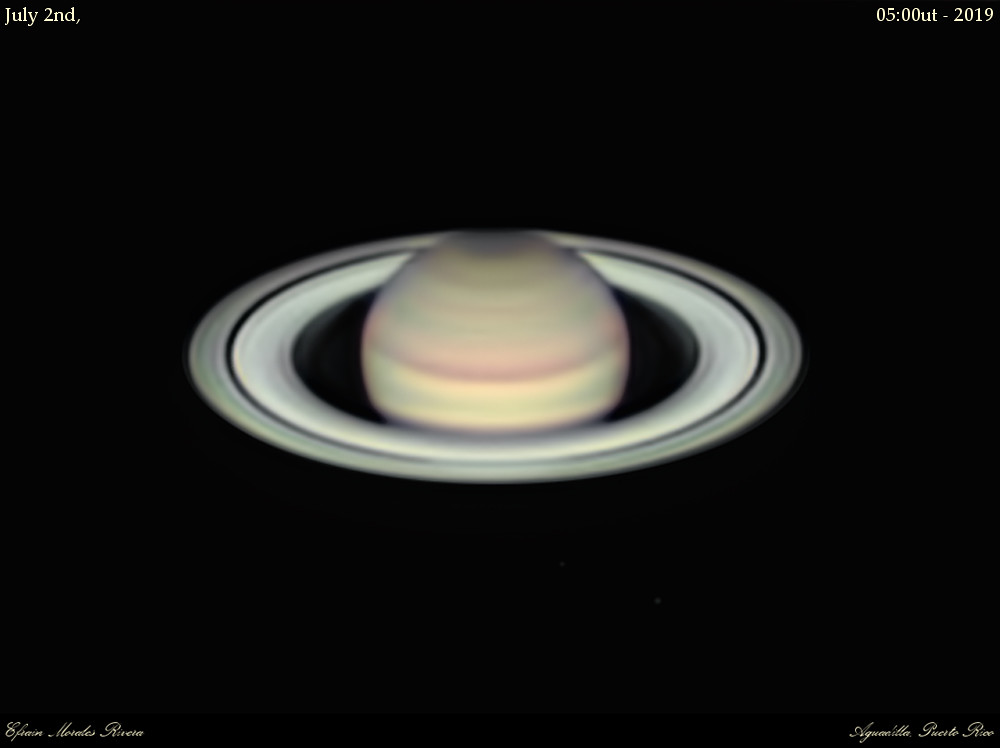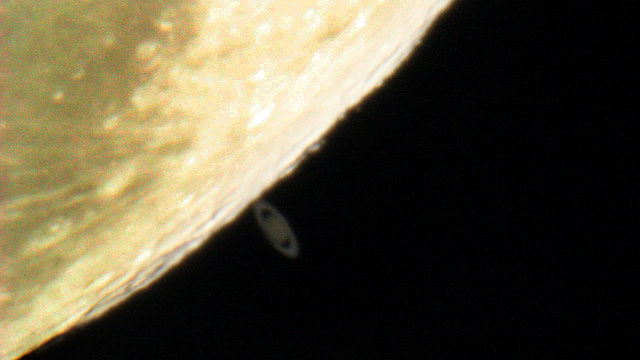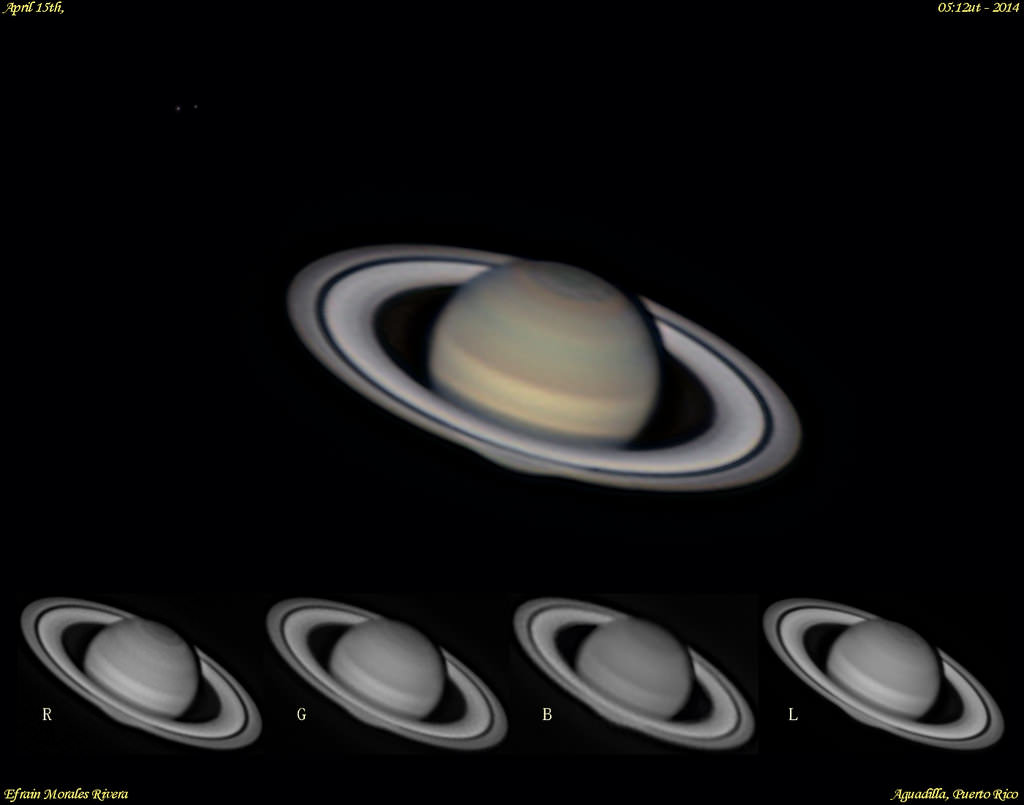Saturn opposition season never disappoints. Slowly, one by one, the planets are returning to the dusk sky. In June, we had Jupiter reach opposition on June 10th. Now, although Mercury and Mars are fleeing the evening scene low to the west at dusk and Venus lingers low in the dawn, magnificent Saturn reaches opposition tonight on July 9th, rising to the east as the Sun sets to the west.
Continue reading “Our Guide to Saturn Opposition Season 2019”See the Moon Photobomb Saturn in an Amazing Capture
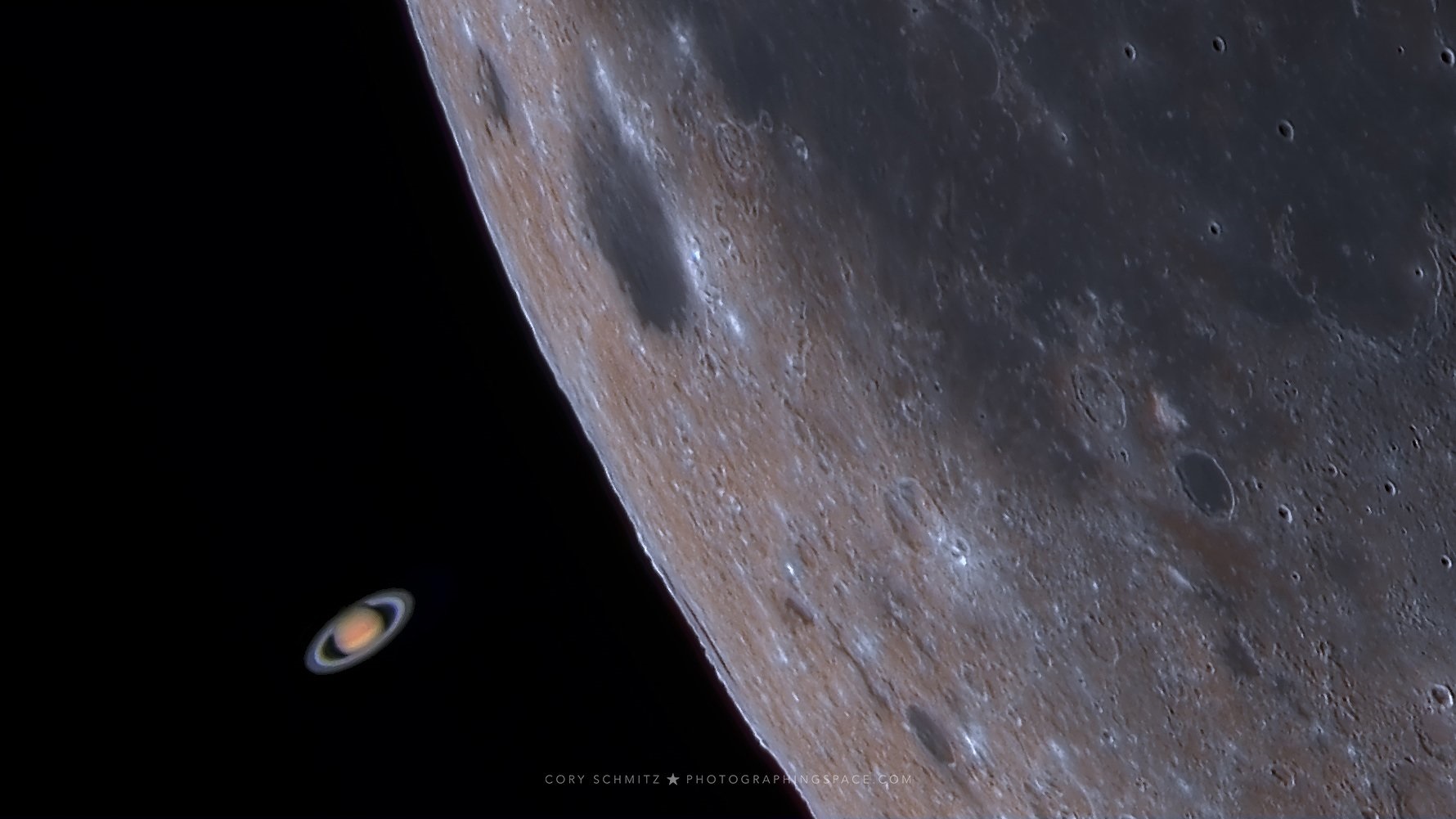
Welcome to Saturn, as you’ve probably never seen it. It’s always awe-inspiring to see the clockwork motion of the heavens, transpire in real time. In a slow motion Universe, occultations give us the chance to see the cosmos pull off a celestial hat-trick. This can appear as a split second-type of event—such as when the Moon, a planet or an asteroid winks out a distant star—or transpire as a leisurely affair as the Moon covers, then uncovers the disk of a planet.
Continue reading “See the Moon Photobomb Saturn in an Amazing Capture”Planets on Parade: Saturn at Opposition 2018
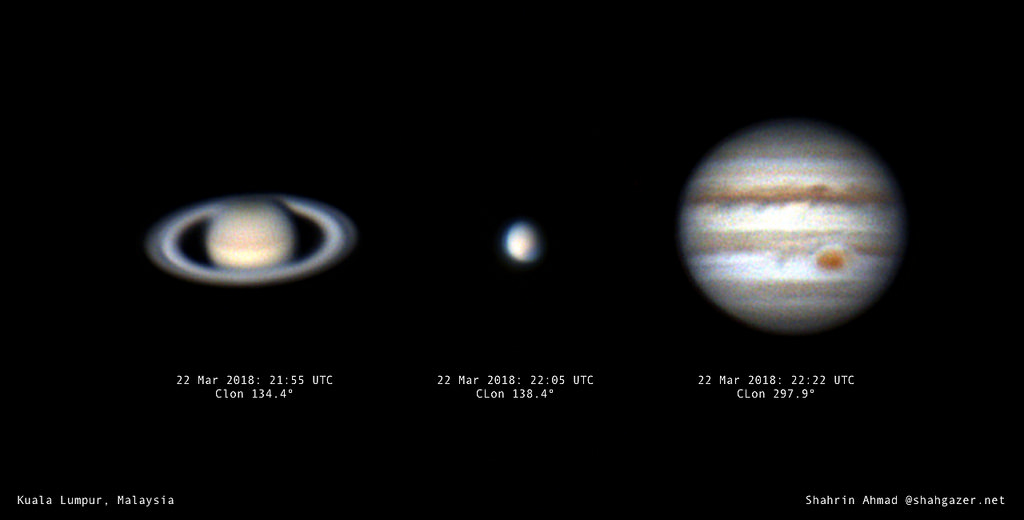
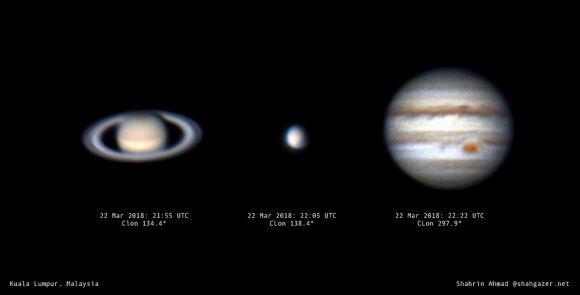
We’re in the midst of a parade of planets crossing the evening sky. Jupiter reached opposition on May 9th, and sits high to the east at dusk. Mars heads towards a fine opposition on July 27th, nearly as favorable as the historic opposition of 2003. And Venus rules the dusk sky in the west after the setting Sun for most of 2018.
June is Saturn’s turn, as the planet reaches opposition this year on June 27th, rising opposite to the setting Sun at dusk.
In classical times, right up until just over two short centuries ago, Saturn represented the very outer limit of the solar system, the border lands where the realm of the planets came to an end. Sir William Herschel extended this view, when he spied Uranus—the first planet discovered in the telescopic era—slowly moving through the constellation Gemini just across the border of Taurus the Bull using a 7-foot reflector (in the olden days, telescopes specs were often quoted referring to their focal length versus aperture) while observing from his backyard garden in Bath, England on the night of March 13th, 1781.
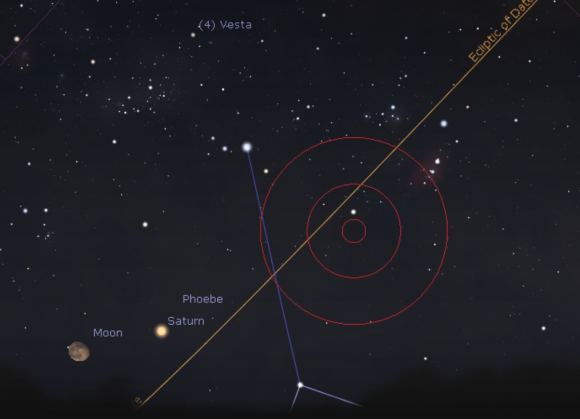
Orbiting the Sun once every 29.5 years, Saturn is the slowest moving of the naked eye planets, fitting for a planet named after Father Time. Saturn slowly loops from one astronomical constellation along the zodiac to the next eastward, moving through one about every two years.
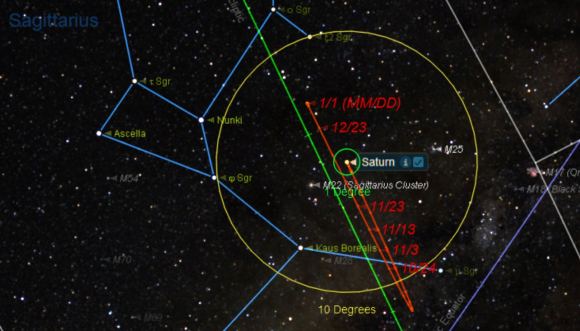
2018 sees Saturn in the constellation Sagittarius the Archer, just above the ‘lid’ of the Teapot asterism, favoring the southern hemisphere for this apparition. Saturn won’t cross the celestial equator northward again until 2026. Not that that should discourage northern hemisphere viewers from going after this most glorious of planets. A low southerly declination also means that Saturn is also up in the evening in the summertime up north, a conducive time for observing. Taking 29-30 years to complete one lap around the ecliptic as seen from our Earthly vantage point, Saturn also makes a great timekeeper with respect to personal life milestones… where were you back in 1989, when Saturn occupied the same spot along the ecliptic?
Saturn also shows the least variation of all the planets in terms of brightness and size, owing to its immense distance 9.5 AU from the Sun, and consequently 8.5 to 10.5 AU from the Earth. Saturn actually just passed its most distant aphelion since 1959 on April 17th, 2018 at 10.066 AU from the Sun.
Saturn’s in 2018 Dates with Destiny
Saturn sits just 1.6 degrees south of the waning gibbous Moon tonight. The Moon will lap it again one lunation later on June 28th. Note that the brightest of the asteroids, +5.7 magnitude 4 Vesta is nearby in northern Sagittarius, also reaching opposition on June 19th. Can you spy Vesta with the naked eye from a dark sky site? 4 Vesta passes just 4 degrees from Saturn on September 23rd, and both flirt with the galactic plane and some famous deep sky targets, including the Trifid and Lagoon Nebulae.
Saturn reaches quadrature 90 degrees east of the Sun on September 25th, then ends its evening apparition when it reaches solar conjunction on New Year’s Day, 2019.
Saturn is well clear of the Moon’s path for most of this year, but stick around: starting on December 9th, 2018, the slow-moving planet will make a great target for the Moon, which will begin occulting it for every lunation through the end of 2019.
It’s ironic: Saturn mostly hides its beauty to unaided eye. Presenting a slight saffron color in appearance, it never strays much from magnitude -0.2 to +1.4 in brightness. One naked eye observation to watch for is a sudden spurt in brightness known as the opposition surge or Seeliger Effect. This is a retro reflector type effect, caused by all those tiny iceball moonlets in the rings reaching 100% illumination at once. Think of how the Full Moon is actually 3 to 4 times brighter than the 50% illuminated Quarter Moon… all those little peaks, ridges and crater rims no longer casting shadows do indeed add up.
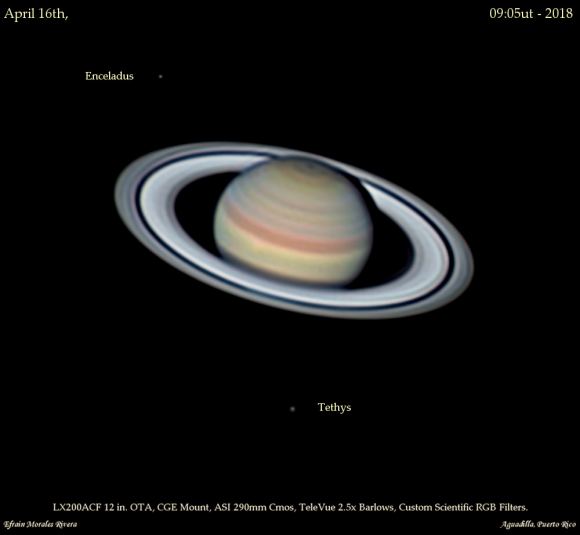
And this effect is more prominent in recent years for another reason: Saturn’s rings passed maximum tilt (26.7 degrees) with respect to our line of sight just last year, and are still relatively wide open in 2018. They’ll start slimming down again over the next few oppositions, reaching edge-on again in 2028.
Even using a pair of 7×50 hunting binoculars on Saturn, you can tell that something is amiss. You’re getting the same view that Galileo had through his spyglass, the pinnacle of early 17th century technology. He could tell that something about the planet was awry, and drew sketches showing an oblong world with coffee cup handles on the side. Crank up the magnification using even a small 60 mm refractor, and the rings easily jump into view. This is what makes Saturn a star party staple, an eye candy feast capable of drawing the aim of all the telescopes down the row.
If seeing and atmospheric conditions allow, crank up the magnification up to 150x or higher, and the dark groove of the Cassini division snaps into view. Can you see the shadow of the disk of Saturn, cast back onto the plane of the rings? The shadow of the planet hides behind it near opposition, then becomes most prominent towards quadrature, when we get to peek around its edge. Can you spy the limb of the planet itself, through the Cassini Gap?
Though the disk of Saturn is often featureless, tiny swirls of white storms do occasionally pop up. Astrophotographer Damian Peach noted just one such short-lived storm on the ringed planet this past April 2018.
Saturn’s retinue of moons are also interesting to follow in there own right. The first one you’ll note is +8.5 magnitude smog-shrouded Titan. Larger in diameter than Mercury, Titan would easily be a planet in its own right, were it liberated from its primary’s domain.
Though Saturn has 62 known moons, only six in addition to Titan are in range of a modest backyard telescope: Enceladus, Rhea, Dione, Mimas, Tethys and Iapetus. Two-faced Iapetus is especially interesting to follow, as it varies two full magnitudes in brightness during its 79 day orbit. Arthur C. Clarke originally placed the final monolith in 2001: A Space Odyssey on this moon, its artificial coating a beacon to astronomers. Today, we know from flybys carried out by NASA’s Cassini spacecraft that the leading hemisphere of Iapetus is coated with dark in-falling material, originating from the dark Phoebe ring around Saturn.

Owners of large light bucket telescopes may also want to try from two fainter +15th magnitude moons: Hyperion and Phoebe.
Fun fact: Saturn’s moons can also cast shadows back on the planet itself, much like the Galilean moons do on Jupiter… the catch, however, is that these events only occur around equinox season in the years around when Saturn’s rings are edge-on. This next occurs starting in 2026.
Cassini finished up its thrilling 20 year mission just last year, with a dramatic plunge into Saturn itself. It will be a while before we return again, perhaps in the next decade if NASA selects a nuclear-powered helicopter to explore Titan. Until then, be sure to explore Saturn this summer, from your Earthbound backyard.
Love to observe the planets? Check out our new forthcoming book, The Universe Today Ultimate Guide to Viewing the Cosmos – out on October 23rd, now up for pre-order.
A Triple Occultation Bonanza: A Challenging Series of Occultations This Weekend and More
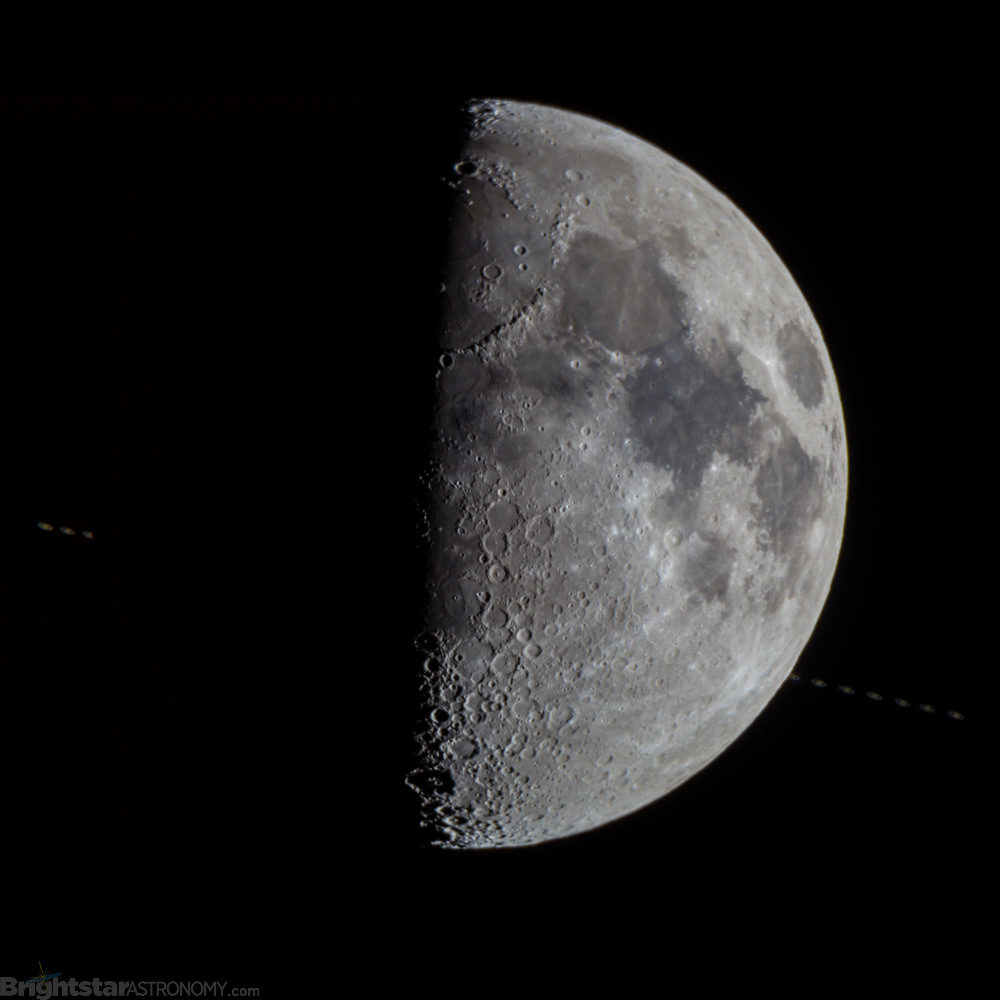
Got clear skies? This week’s equinox means the return of astronomical Fall for northern hemisphere observers and a slow but steady return of longer nights afterwards. And as the Moon returns to the evening skies, all eyes turn to the astronomical action transpiring low to the southwest at dusk.
Three planets and two “occasional” planets lie along the Moon’s apparent path this coming weekend: Mars, Saturn, Mercury and the tiny worldlets of 4 Vesta and 1 Ceres. Discovered in the early 19th century, Ceres and Vesta enjoyed planetary status initially before being relegated to the realm of the asteroids, only to make a brief comeback in 2006 before once again being purged along with Pluto to dwarf planet status.
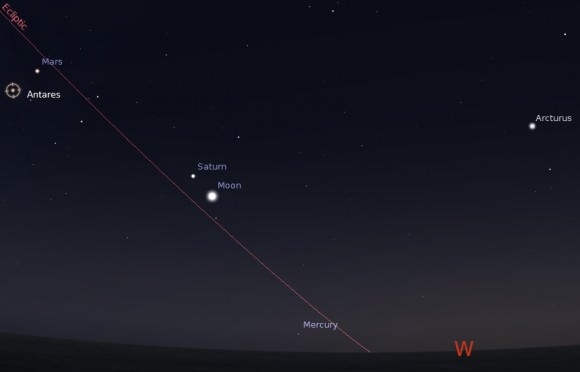
On Sunday September 28th, the four day old Moon will actually occult (pass in front of) Saturn, Ceres, and Vesta in quick succession. The Saturn occultation is part of a series of 12 in an ongoing cycle. This particular occultation is best for Hawaiian-based observers on the evening of September 28th. Astute observers will recall that Ceres and Vesta fit in the same 15’ field of view earlier this summer. Both are now over six degrees apart and slowly widening. Unfortunately, there is no location worldwide where it’s possible to see all (or two) of these objects occulted simultaneously. The best spots for catching the occultations of +7.8 magnitude Vesta and +9.0 magnitude Ceres are from the Horn of Africa and just off of the Chilean coast of South America, respectively. The rest of us will see a close but photogenic conjunction of the trio and the Moon. To our knowledge, an occultation of Ceres or Vesta by the dark limb of the Moon has yet to be recorded. Vesta also reaches perihelion this week on September 23rd at 4:00 UT, about 2.2 astronomical units from the Sun and 2.6 A.U.s from Earth.
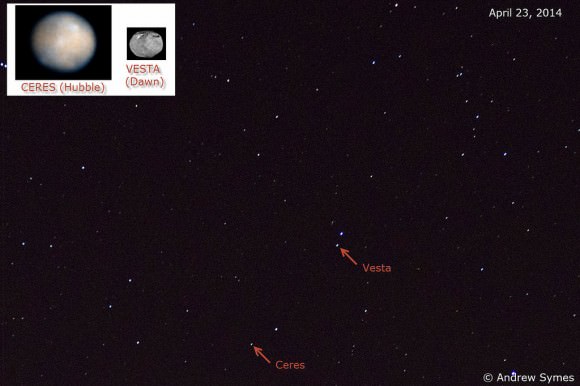
The reappearance of the Moon in the evening skies is also a great time to try your hand (or eyes) at the fine visual athletic sport of waxing crescent moon-spotting. The Moon passes New phase marking the start of lunation 1135 on Wednesday, September 24th at 6:12 UT/2:12 AM EDT. First sighting opportunities will occur over the South Pacific on the same evening, with worldwide opportunities to spy the razor-thin Moon low to the west the following night. Aim your binoculars at the Moon and sweep about three degrees to the south, and you’ll spy Mercury and the bright star Spica just over a degree apart.
This week’s New Moon is also notable for marking the celebration of Rosh Hashanah, and the beginning of the Jewish year 5775 A.M. at sundown on Wednesday. The Jewish calendar is a hybrid luni-solar one, and inserted an embolismic or intercalculary month earlier this spring to stay in sync with the solar year.
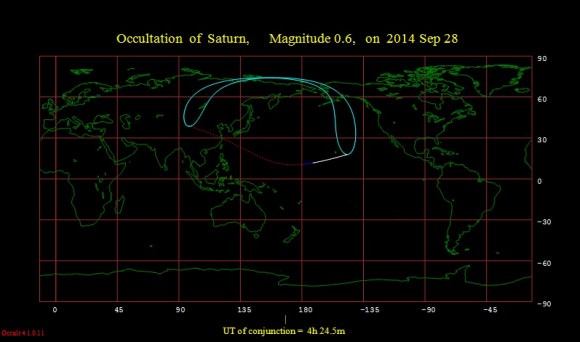
The Moon also visits Mars and Antares on September 29th. The ruddy pair sits just three degrees apart on the 28th, making an interesting study in contrast. Which one looks “redder” to you? Antares was actually named by the Greeks to refer to it as the “equal to,” “pseudo,” or “anti-Mars…” Mars can take on anything from a yellowish to pumpkin orange appearance, depending on the current amount of dust suspended in its atmosphere. The action around Mars is also heating up, as NASA’s MAVEN spacecraft just arrived in orbit around the Red Planet and India’s Mars Orbiter is set to join it this week… and all as Comet A1 Siding Spring makes a close pass on October 19th!
And speaking of spacecraft, another news maker is photo-bombing the dusk scene, although of course it’s much too faint to see. NASA’s Dawn mission is en route to enter orbit around Ceres in early 2015, and currently lies near R.A. 15h 02’ and declination -14 37’, just over a degree from Ceres as seen from Earth. The Moon will briefly “occult” the Dawn spacecraft as well on September 28th.
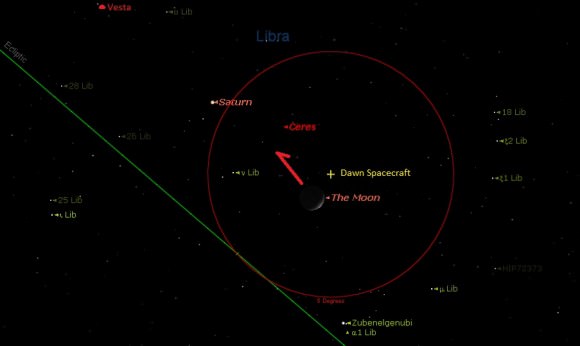
Be sure to keep an eye out for Earthshine on the dark limb of the Moon as our natural neighbor in space waxes from crescent to First Quarter. What you’re seeing is the reflection of sunlight from the gibbous Earth illuminating the lunar plains on the nighttime side of the Moon. This effect gives the Moon a dramatic 3D appearance and can vary depending on the amount of cloud and snow cover currently facing the Moon.
Such a close trio of conjunctions raises the question: when was the last time the Moon covered two or more planets at once? Well, on April 23rd 1998, the Moon actually occulted Venus and Jupiter at the same time, although you had to journey to Ascension Island to witness it!
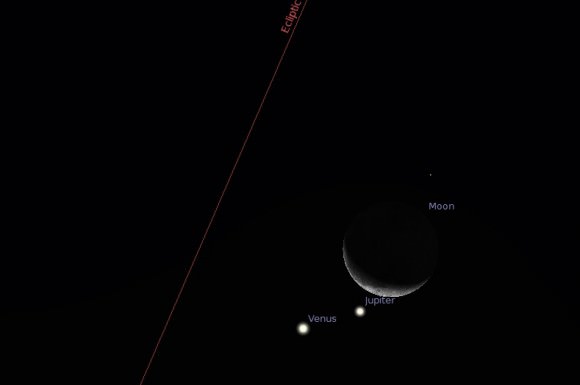
Such bizarre conjunctions are extremely rare. You need a close pairing of less than half a degree for two bright objects to be covered by the Moon at the same time. And often, such conjunctions occur too close to the Sun for observation. A great consequence of such passages, however, is that it can result in a “smiley-face” conjunction, such as the one that occurs on October 15th, 2036:
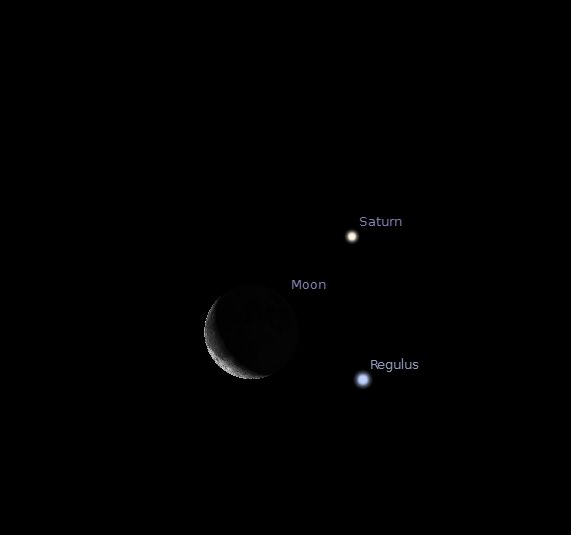
Such an occurrence lends credence to a certain sense of cosmic irony in the universe.
And be sure to keep an eye on the Moon, as eclipse season 2 of 2 for 2014 kicks off next week, with the second total lunar eclipse of the year visible from North America.
More to come!
A Spectacular Set of Conjuctions on Tap for the Moon, Mars and Saturn this Weekend
Got clear skies this July 4th weekend? The Moon passes some interesting cosmic environs in the coming days, offering up some photogenic pairings worldwide and a spectacular trio of occultations for those well placed observers who find themselves along the footprint of these events.
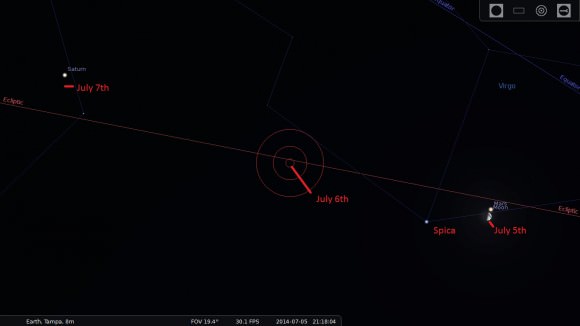
First, let’s look at our closest natural neighbor in space. The Moon reaches first quarter phase on Saturday, July 5th at 11:59 Universal Time (UT)/7:59 AM EDT. First Quarter is a great time to observe the Moon, as the craters along the jagged terminator where the Sun is just starting to rise stand out in stark profile. Watch for the Lunar Straight Wall and the alphabet soup of elusive features known as the Lunar X or Purbach Cross and Lunar V on evenings right around First Quarter phase.
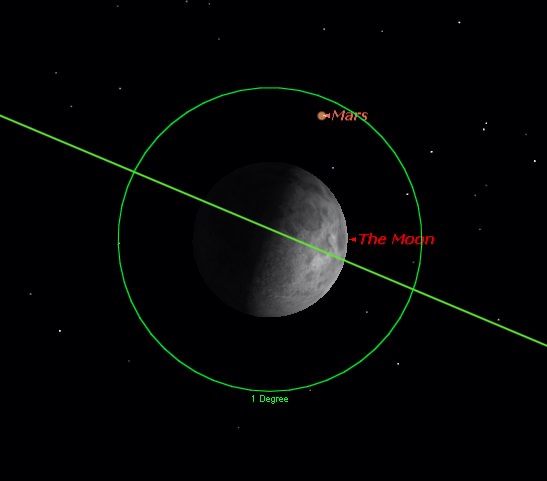
Our first conjunction stop on this weekend’s lunar journey is the planet Mars. Although the Moon occults — that is, passes in front of a given planet from our Earthly perspective — exactly 16 naked eye planets in 2014 (24 if you add in Uranus events and 1 Ceres and 4 Vesta on September 28th), the Moon will only occult Mars once in 2014, on the night of July 5th/6th. Northern South America and southern Central America will have a front row seat, while the rest of North America will see a close pass less than one degree from the lunar limb. This will still present a fine photographic opportunity, as it’ll be possible to snag Mars and the limb of the Moon in the same field of view. The Moon will be 56% illuminated during the conjunction, and Mars will present an 88% illuminated disk 9.2” across shining at magnitude +0.3.
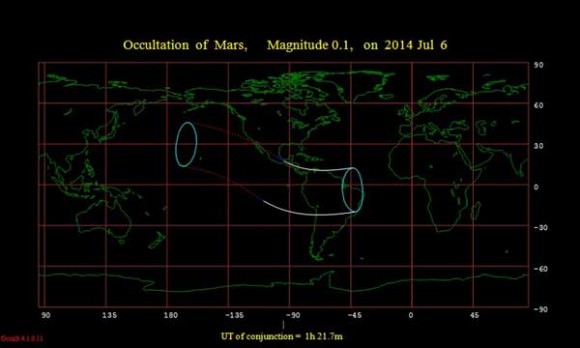
Both will be 96 degrees east of the Sun during geocentric (Earth-centered) conjunction, which occurs around 1:00 UT on July 6th or 9:00 PM EDT on the evening of the 5th. For those positioned to catch the occultation, it’ll take about a minute for “Mars set” to occur on the lunar limb. The last occultation of Mars occurred on May 9th, 2013 and the next won’t happen ‘til March 21st, 2015.
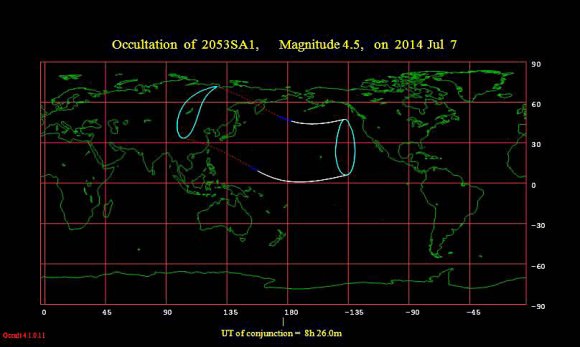
Next up, the Moon occults the +4.5th magnitude star Lambda Virginis on July 7th centered on 8:26 UT. This event is well placed for observers in Hawaii on the evening of July 6th. Located 187 light years distant, the light that you’re seeing departed the far-flung star on 1827, only to be interrupted by the pesky limb of our Moon a second prior to arrival on Earth. This star is also of note as it’s a spectroscopic binary, and while you won’t be able to resolve the pair at a tiny separation of just 0.0002” apart, you just might be able to see the pair “wink out” in a step wise fashion that betrays its binary nature. The Moon misses the brightest star in Virgo (Spica) this month, as it’s wrapped up a series of occultations of the star in early 2014 and won’t resume until 2024. Aldebaran, Antares and Regulus also lie along the Moon’s path on occasion, and the next cycle of bright star occultations resume with Aldebaran in January 2015. You can check out a list of fainter naked eye stars occulted by the Moon this year here courtesy of the International Occultation Timing Association.
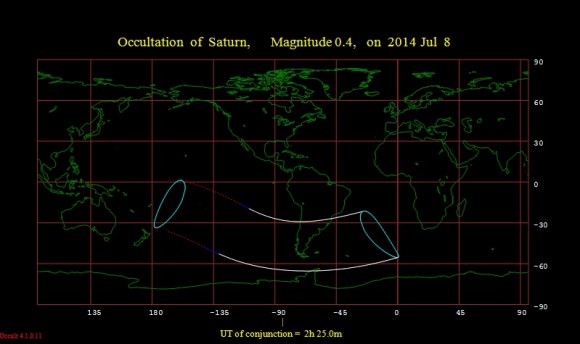
And finally, the Moon visits Saturn, now residing just over the border in the astronomical constellation of Libra. This occultation occurs just 49 hours after the Mars event at 2:00 UT on July 8th (10:00 PM EDT on the evening of July 7th) and favors observers in the southernmost tip of South America. As with Mars, North America will see a close miss, although it will also be possible to squeeze Saturn in the same field of view as the Moon at low power, though it’ll sit about a degree of off its limb. We’re in a cycle of occultations of Saturn this year, with 11 occurring in 2014 and the next on August 4th. The reason for this is that Saturn moves much more slowly across the sky than Mars from our perspective, making for a relatively sluggish moving target for the Moon. Saturn shines at +0.6 magnitude as the 75% illuminated Moon passes by and subtends 42” with rings and will take about five minutes to pass fully behind the Moon.
These events will make for some great pics and animation sequences for sure… can you spot Saturn or Mars near the lunar limb with binoculars or a telescope before sunset? Or catch ‘em in the frame during a local fireworks show? Let us know, if enough pics surface on Universe Today’s Flickr page, we may do a post weekend roundup!
Catch the Dramatic June 10th Occultation of Saturn by the Moon
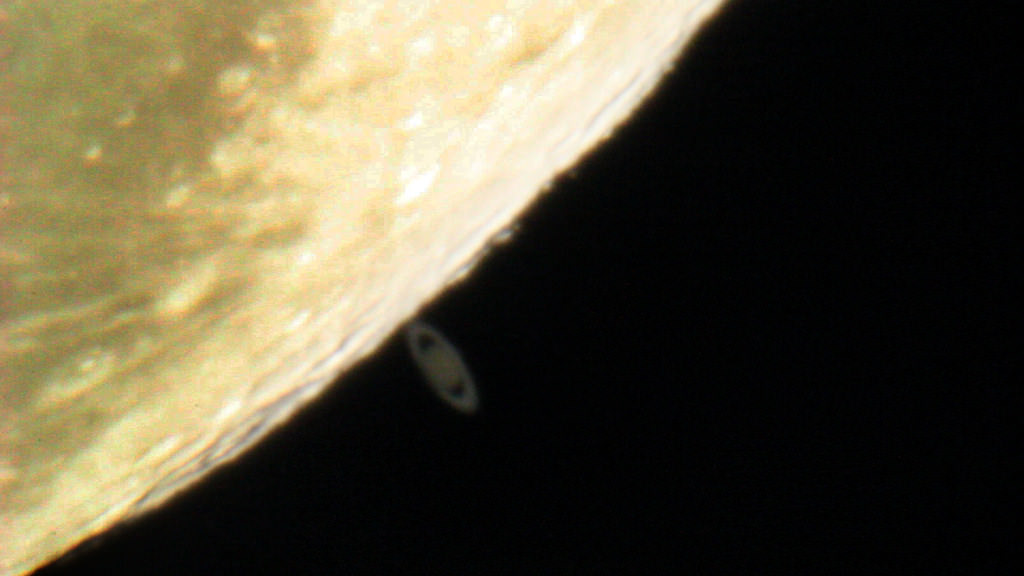
Some terms in astronomy definitely have a PR problem, and are perhaps due for an overhaul. One such awkward term is occultation, which simply means that one celestial body is passing in front of another from an observer’s vantage point, nothing more, and nothing less. I know, the word ‘occult’ is in there, raising many a non-astronomically minded eyebrow and evoking astronomy’s hoary astrological past. You can even use it as a verb in this sense, as in to ‘occult’ one body with another. A planet or asteroid can occult a star, your cat can occult your laptop’s screen, and the Moon can occult a star or planet, as occurs on Tuesday, June 10th when the waxing gibbous Moon occults the planet Saturn for observers across the southern Indian Ocean region.
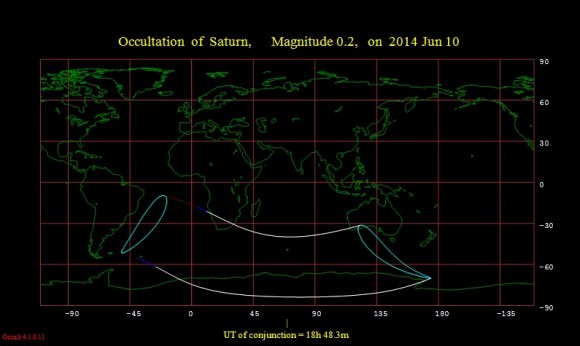
Of course, most of us will see a near miss worldwide. This is parallax in motion, as differing vantage points on the surface of the planet Earth see the Moon against a different starry background.
And we’re currently in the midst of a cycle of occultations of the planet Saturn in 2014, as the Moon occults it 11 times this year, nearly once for every lunation. The Moon actually occults planets 22 times in 2014, 24 if you count the occultations of 1 Ceres and 4 Vesta on September 28th, with Saturn getting covered by the Moon once again on the same date! Saturn tops the list in the number of times it’s occulted by the Moon this year, as it’s the slowest moving of the planets and fails to hustle out of the Moon’s way until November, after which a series of occultations of the ringed planet won’t resume again until December 9th, 2018.
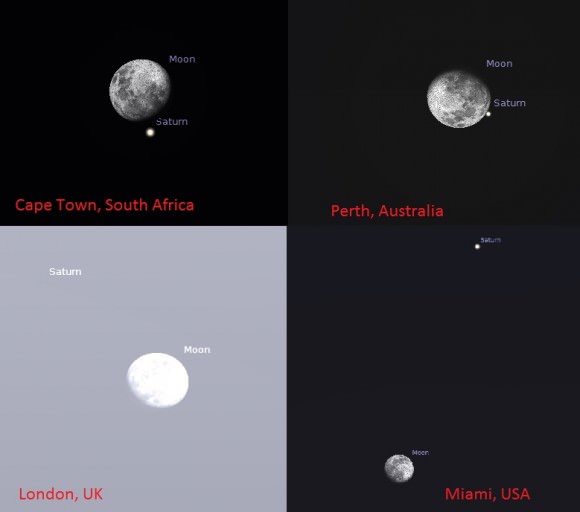
The shadow footprint of the June 10th occultation just makes landfall over southwestern Australia near Perth, a slice of Antarctica, and a scattering of southern Indian Ocean islands and the southern tip of South Africa in and around Cape Town. Note that the phase of the Moon is changing by about 30 degrees of ecliptic longitude as well during each successive occultation of Saturn. Next week’s event occurs as the Moon is at a 93% waxing gibbous illuminated phase this month and soon will occur when the Moon is a crescent. What’s especially interesting is the dark limb of the Moon is always the leading edge during waxing phases; this means that any stars or planets in its way get hidden (or ingress) under its shady nighttime edge.
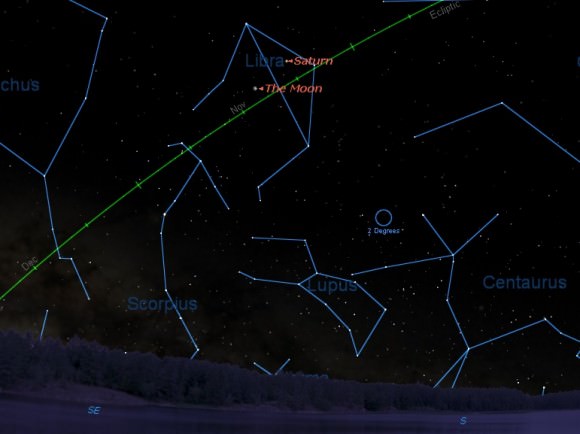
Central conjunction for Saturn and the Moon actually occurs at around 19:00 Universal Time on June 10th. The Moon rises at around 6:00 PM local on this date, and North American observers will see Saturn 4 degrees from the limb of the Moon and at an elevation of 28 degrees above the horizon at dusk. Unfortunately, the best occultation of Saturn by the Moon for North America in 2014 occurs in the daytime on August 31st, though you can indeed catch Saturn in the broad daylight through a telescope with good sky transparency if you know exactly where to look for it… a nearby daytime Moon certainly helps!
Unlike stellar occultations, blockages of planets by the Moon are leisurely events, and lend themselves to some pretty amazing video sequences. You can actually get a sense of the motion of the Moon as you watch it slowly cover the planet’s disk, in real time. It might also be fun to catch the occultation of Saturn’s brightest moon, +9th magnitude Titan. Hey, a moon occulting a moon, a sort of cosmic irony…
Saturn spends all of 2014 in the astronomical constellation of Libra. The Moon moves on to Full on Friday the 13th — triskaidekaphobics take note — at 4:13 UT/00:13 AM EDT. This is the closest Full Moon to the northward solstice which occurs on June 21st at 10:51 UT/6:51 AM EDT, meaning that while the Sun rides high in the sky during the day, the rising Full Moon transits low to the south at night. In the southern hemisphere, the reverse is true in June.
The June Full Moon is also known as per ye ole Farmer’s Almanac as the Strawberry or Rose Moon.
So there you have it, occultations were evoked no less than 21 times in the writing of this post. We need a modern, hip, internet ready meme to supplant the term occultation… y’know, like “ring of fire” for and annular eclipse or minimoon for an apogee moon, etc… blockage? Covering? Enveloping? Let us know what you think!
Saturn at Opposition: Our 2014 Guide
Planet lovers can rejoice: one of the finest jewels of the solar system in returning to the evening night sky.
The planet Saturn reaches opposition next month on May 10th. This means that as the Sun sets to the west, Saturn will rise “opposite” to it in the east, remaining well positioned for observation in the early evening hours throughout the summer season. In fact, we’ll have four of the five naked eye planets above the horizon at once for our evening viewing pleasure in the month of May, as Jupiter also rides high to the west at sunset, Mars just passed opposition last month and Mercury reaches greatest eastern elongation on May 25th. Venus is the solitary holdout, spending a majority of 2014 in the dawn sky.
Saturn will shine at magnitude +0.3 this month and its disk spans an apparent 19,” or 44” if you take into account the apparent width of its rings. The rings are currently tipped open 22 degrees with respect to our line of sight. The ring opening is widening, and will reach a maximum of over 25 degrees in 2017 before the trend reverses. Anyone who remembers observing Saturn back in 2009 will recall that its rings were edge on to our view. This widening of Saturn’s rings also lends itself to a curious effect: although we’re in a cycle of oppositions that are getting farther away — Saturn is 12.5 million kilometres or 0.083 Astronomical Units (A.U.s) more distant in 2014 than it was during opposition last year as it’s headed towards aphelion in 2018 — its widening rings are actually making it appear a bit brighter.
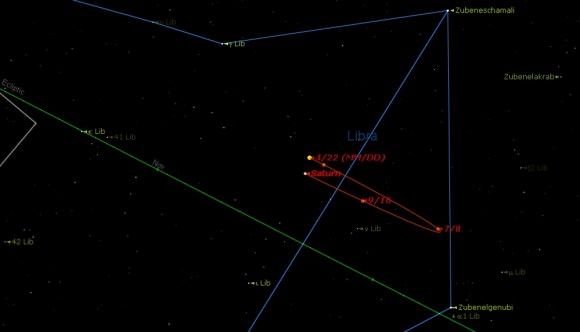
This year’s opposition will find Saturn in the astronomical constellation of Libra, where it’ll spend most of 2014. Oppositions of the ringed planet are set to continue to “head south” until 2018, and won’t occur north of the celestial equator again until 2026. I remember when oppositions of Saturn returned to the constellation Virgo a few years back — where I had first looked at it with my 60mm Jason refractor as a teenager — and realizing that I had now been into observational astronomy for roughly one “Saturnian year.”
The ancients had little knowledge of how unique Saturn was. The faintest and slowest moving of the classical planets, even Galileo knew that something was up when he turned his first primitive telescope towards it. His sketches depict Saturn as something similar to a double handled coffee cup, a testament to how poor his view really was. It wouldn’t be until Christiaan Huygens in 1655 that the true nature of Saturn’s rings was deduced as a flat and separate feature from the disk.
At opposition, the disk of the planet casts a shadow straight back from our point of view. This vantage slowly changes as the planet moves towards eastern quadrature on August 9th and we get a glimpse slightly off to one side of the planet. After opposition, the shadow of the disk can again be seen casting back onto the rings.
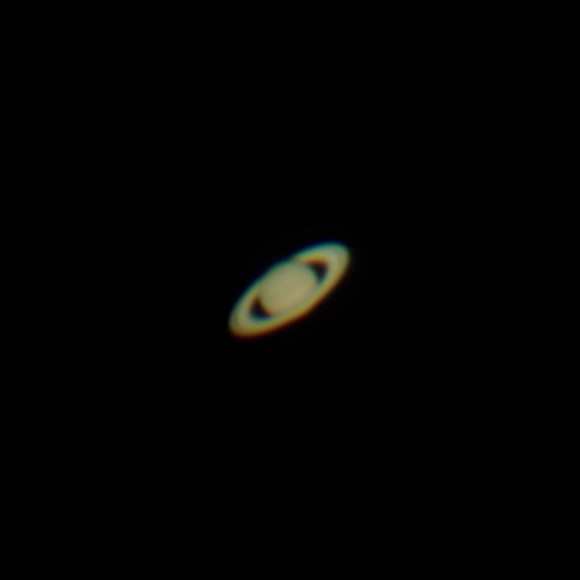
Another interesting phenomenon to watch out for near opposition is known as the Seeliger effect. Also sometimes referred to as the “opposition surge,” this sudden brightening of the disk and rings is a subtle effect, as the globe of Saturn and all of those tiny little ice crystals reach 100% illumination. This effect can be noted to the naked eye on successive nights around opposition, and will get more prominent towards 2017. Coherent-backscattering of light has also been proposed as a possible explanation of this phenomenon. Perhaps a video sequence capturing this effect is in order for skilled astro-imagers in 2014.
Through a small telescope, the first feature that becomes apparent is Saturn’s glorious system of rings. Crank up the magnification, and you’ll note a dark groove in the ring system. This is the Cassini Division, first described by Giovanni Cassini in 1675.
Here’s a challenge we came across some years back: can you see the disk of Saturn through the Cassini Division? Right around opposition is a good time to attempt this unusual feat of visual athletics.
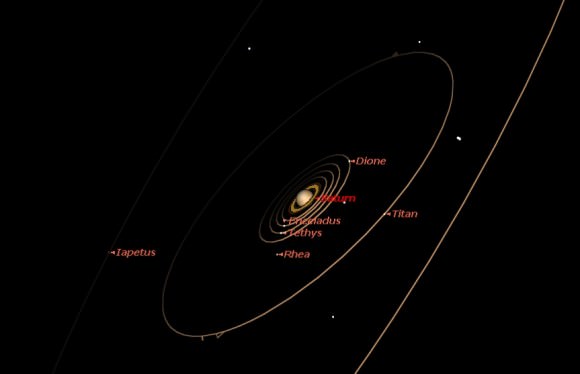
Saturn’s large moon Titan is an easy catch at magnitude +8 in a small telescope. Titan is the second largest moon in the solar system. Place it in a direct orbit about the Sun, and it would be considered a planet, no problem. 7 of Saturn’s 62 known moons are within reach of a small telescope. In addition to Titan, they are, with quoted magnitudes: Mimas (+13), Enceladus (+12), Tethys (+10), Rhea (+10), Dione (+11) and Iapetus. Iapetus is of special interest, as it brightens from +11.9 to magnitude +10.2 as it traces out its 79 day orbit. We always knew there was something unique about this moon, and NASA’s Cassini mission revealed the world to have two distinctly different hemispheres with vastly different albedos during its close 2007 flyby.
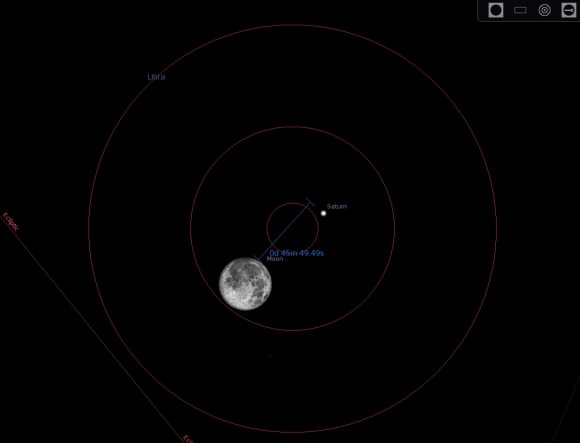
Also, be sure to check out Saturn on the night of May 14th — just 4 nights after opposition — as the Full Moon sits less than a degree south of the ringed planet. Can you see both in the same telescopic field of view? Can you nab Saturn next to the rising daytime Moon low to the horizon just before local sunset? The Moon will actually occult (pass in front of) Saturn for viewers based in Australia and New Zealand on the 14th. This is only one of 11 occultations — nearly one for each lunation — of Saturn by the Moon in 2014. Unfortunately, the best one for North America occurs in the daytime on August 31st, though it too may be observable telescopically.
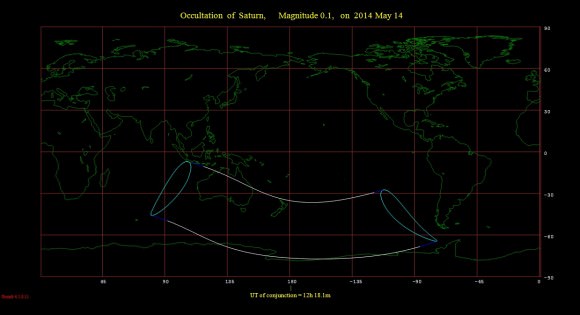
Finally, this evening apparition of the planet runs through northern hemisphere summer and fall until Saturn reaches solar conjunction on November 18th. So get those homemade planetcams out, send those pics in to Universe Today, and be sure to join in to the Virtual Star Party every Sunday Night… Saturn is sure to be featured!
The Moon Occults Saturn in the Dawn this Weekend
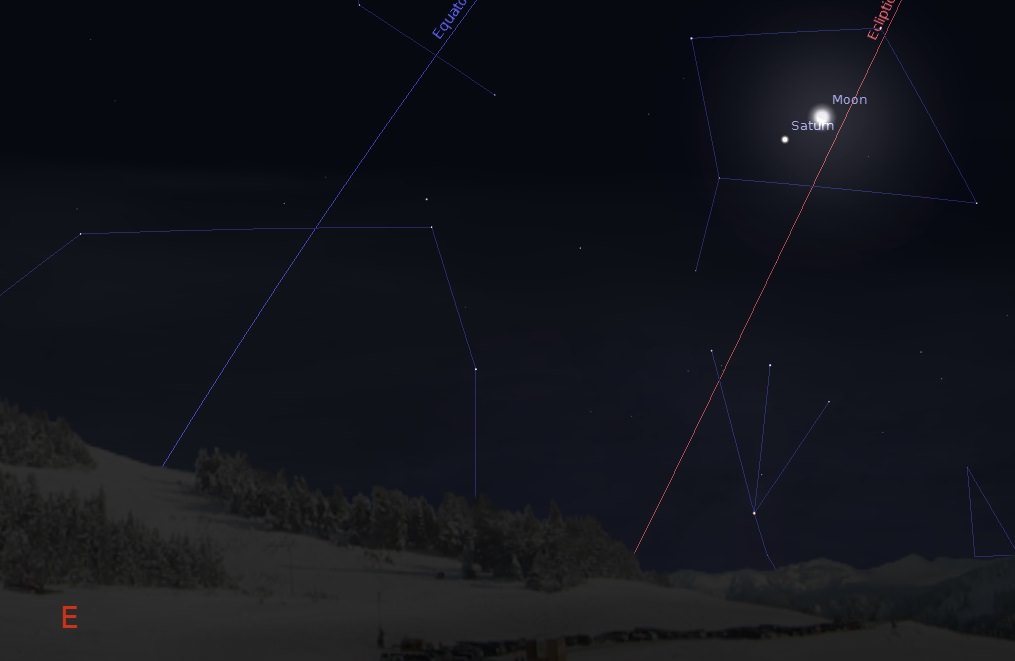
Mark your calendars: the first in a series of interesting occultations of Saturn by the Moon for 2014 starts this weekend.
The year 2014 features 11 occultations of the planet Saturn by the Moon, and there are 23 total for 2014 of every planet except Neptune and Jupiter.
An occultation occurs when one foreground celestial object completely obscures another. Technically, a total solar eclipse is an occultation of the Sun by the Moon, although it’s never referred to as such. The term finds modern usage mainly for the blocking of stars and planets by the Moon. Very occasionally, an asteroid or planet can occult a distant star as well.
And yes, the modern astronomical term “occultation” traces its hoary roots back to the days when astronomy was intertwined with the pseudoscience of astrology. To this day, the term still makes some folks wonder if astronomers are secretly casting horoscopes. Trust us, you’re still on a solid astronomical footing to use the term “occultation.”
Unfortunately, the January 25th occultation of Saturn by the Moon will only grace part of Antarctica, southern Argentina and Chile, and the Falkland Islands post-sunrise. The rest of us still will see a very photogenic pass of Saturn near the waning crescent Moon on the morning of Saturday, January 25th. The Moon will pass just about a degree — two times its apparent width — south of Saturn for northern hemisphere observers.
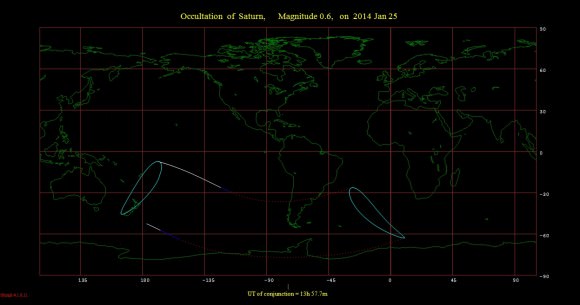
Both the Moon and Saturn will reside in the astronomical constellation of Libra this weekend during closest passage. The pair will rise around 2 AM local. After their brief tryst, the Moon will head towards New on January 30th while Saturn will continue to rise successively earlier as its heads towards opposition and the start of evening Saturn observing season on May 10th, 2014.
January 2014 is also notable for having two New Moons, an occurrence informally known as a Black Moon. This occurs again this year in March, and February 2014 is devoid of a New Moon. February is the only month that can be “missing a Moon phase” as it’s the only one shorter the synodic period of 29.5 days, in which the Moon returns to like phase.
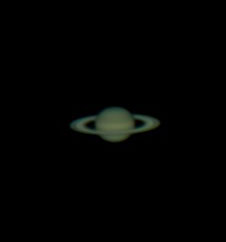
In the telescope, Saturn will present a +0.8 magnitude disk 16” across (38” with rings from tip-to-tip). Saturn’s rings are tipped open to our line of sight by about 22 degrees in 2014, and are widening towards a maximum of 27 degrees in 2016 through 2017. If you have an equatorial telescope with tracking capability, it may be possible this weekend to follow Saturn up into the daytime sky. Though Saturn isn’t quite bright enough to see in the daytime unaided, it might just be possible to spy using binoculars on the 25th using the nearby crescent Moon as a guide. Saturn is a tough daytime target to be sure, but it’s not impossible to acquire with a little skill and patience.
The current cycle of occultations of Saturn began on December 1st, 2013 and ends on November 22nd, 2014. The cycle will move progressively northward through the year.
The Moon and Saturn put on a repeat performance over almost the same exact location (this time in darkness) on April 17th, 2014, and the best event in the cycle for North America will be the August 31st daytime occultation of Saturn by the waxing crescent Moon.
Now for the wow factor of what you’re seeing. On Saturday morning, the Moon is just over 371,000 kilometres distant, or a little over a light second away. Saturn is over four thousand times more remote at just over 10.1 astronomical units (AUs) distant, which works out to 1.5 billion kilometres, or over 83 light minutes away. And although the Moon is over a 112 times larger in apparent diameter than Saturn as seen from the Earth, the globe of Saturn is actually over 34 times bigger.
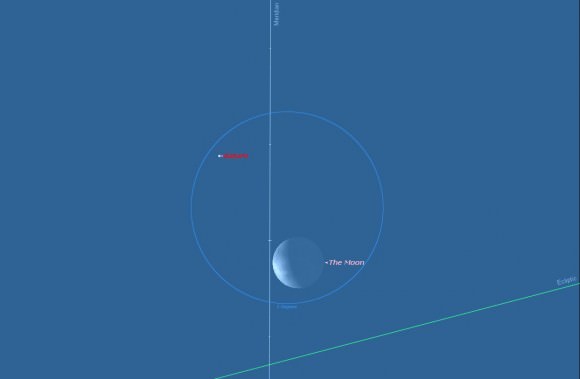
And though we’ve been to the Moon lots since the dawn of the Space Age, only two spacecraft (Voyagers 1 and 2) have made brief flybys of the ringed world, and only one – Cassini – has orbited it. Note that China’s Chang’e-3 lander and rover are about to experience their second sunset this weekend as well from the lunar surface since landing on the Moon last month.
And although lots of planets get occulted by the Moon in 2014, no stars brighter than +1st magnitude lie in its path. In fact, the next cycle of bright star occultations by the Moon doesn’t resume until the Moon meets Aldebaran in January 29th, 2015.
There are, however, over a 100 lesser events involving the Moon occulting naked eye stars worldwide in 2014. Two such events occur this week as well, when the 48% illuminated Moon occults the +4.5th magnitude star Lambda Virginis for west-central South America on the morning of January 24th, and the occultation of the +2.8th magnitude star Alpha Librae (Zubenelgenubi) for central Asia on January 25th.
Don’t miss these celestial events, and be sure to send those pics in to Universe Today… there’s something for everyone happening in the sky this week worldwide!

